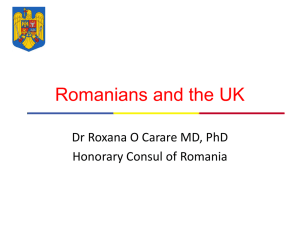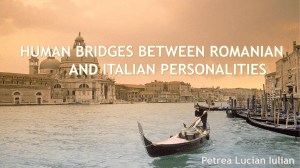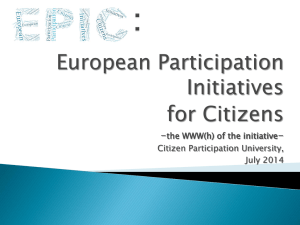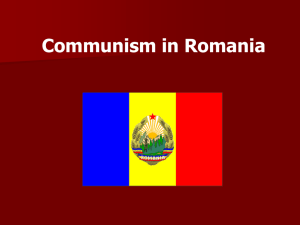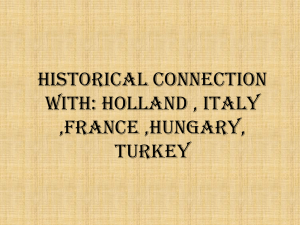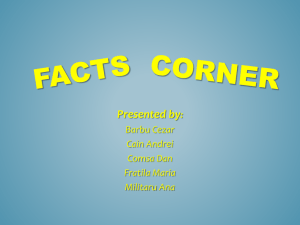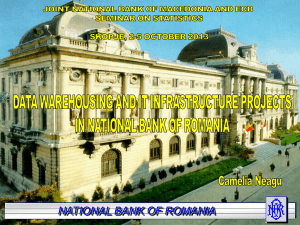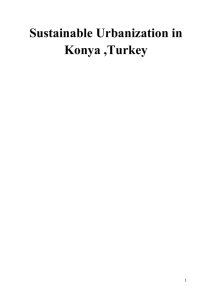Migration in Romania
advertisement
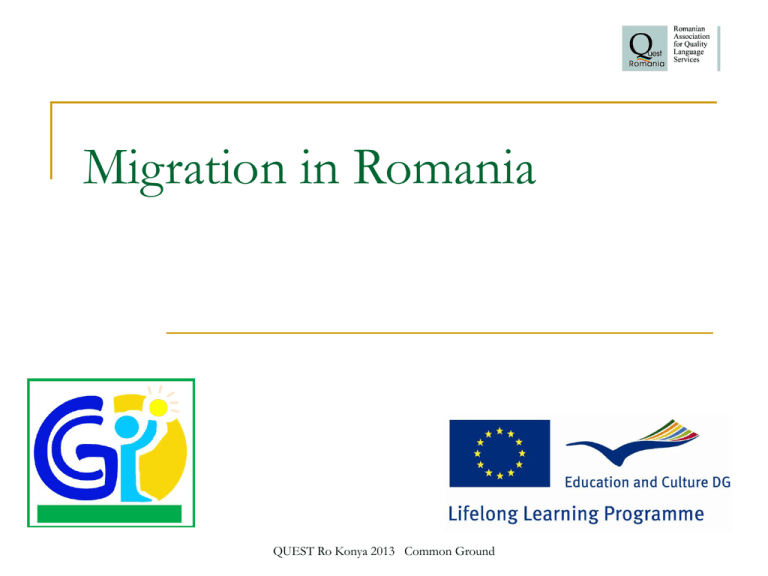
Migration in Romania QUEST Ro Konya 2013 Common Ground In this presentation: Which is the place of international migration in Romania Immigration – Labour Immigrants Emigration – Euro-commuters Final Remarks Webography Filmography QUEST Ro Konya 2013 Common Ground Fortress Europe Romania hosts a considerable number of immigrants, mainly from Asia and Africa. Most of them are labour migrants (the majority from Asia) and political refugees seeking political asylum (the majority from Africa). The phenomenon of immigration to Romania has increased considerably since Romania’s accession to the European Union on January 1, 2007. Since 2007, some immigrants’ communities have already outnumbered some small ethnic minorities in Romania QUEST Ro Konya 2013 Common Ground Shortcomings the Romanian state has not implemented efficient laws to meet the needs of the new Immigration framework. the Romanian education system has not developed any new intercultural (not even multicultural) curricula for the immigrants’ children. QUEST Ro Konya 2013 Common Ground Overview of Romania’s international legislation ratification the United Nations Convention Relating to the Status of Refugees (1951) in 1991, the Convention against Torture and Other Cruel, Inhuman or Degrading Treatment or Punishment (1984) in 1990, the Council of Europe Convention on Action against Trafficking in Human Beings (2005) in 2006. QUEST Ro Konya 2013 Common Ground Legal Framework Romania still neither has signed nor ratified the Convention on the Protection of the Rights of All Migrant Workers and Members of Their Families (1990). But the Romanian legal framework does not punish any asylum seeker or refugee for residing (il)legally on Romanian territory, but offers protection against refoulment to migrants whose lives are endangered in their home countries QUEST Ro Konya 2013 Common Ground Romania is still more often regarded as a transit country Despite the increasing number of asylum seekers the number of transit migrants is still larger than the number of immigrants who settle down in Romania. In 2012 Romania registered 59,017 legal immigrants: 49,497 temporary and 9,520 permanent residents. Most of the temporary foreign residents were: Romanian citizens’ family members/relatives (17,264), students (12,510) and labor migrants (9,347), Approximately 1,000 individuals were refugees, benefiting from some kind of protection from the Romanian state, while residing on Romanian territory. QUEST Ro Konya 2013 Common Ground Romanian society proves to be a tolerant and admissive one The population has a neutral-to-positive perception of immigrants: 47.3% declare to have neither a negative, nor a positive image of immigrants, 33.3% declare that they have a clearly positive image, only 9.9% have a negative one. (The single instance where they may be perceived as a menace is on the job market: they accept lower-paid jobs and therefore they are blamed for taking away the vacancies of the Romanian citizens). QUEST Ro Konya 2013 Common Ground The Romanian population is misinformed about the conditions of the immigrants their real number is about 60,000, one third of Romanians thinks there are over a million foreigners in Romania; only 14.6% approach the correct number of immigrants. 30% of the Romanians believe there are 100,000 refugees in Romania, it is an alarming fact that 80% of the Romanians have never had any direct contact to immigrants: no direct communication and they have never known an Immigrant personally QUEST Ro Konya 2013 Common Ground Moreover 71% of Romanians are not familiar with any kinds of services that the Romanian authorities (should) offer to the immigrants 79% do not know the rights of the foreign migrants while residing on the territory of Romania. QUEST Ro Konya 2013 Common Ground Legal labour immigrants Romania receives the largest number of labour migrants from: China (33.77%), Turkey (32.40%), the Republic of Moldova (08.01%), Vietnam (04.78%) and the Philippines (01.94%) (http://www.migrant.ro/file/pagesleft/264migrantinromanianr7ptweb.pdf).' target='_blank' title=''>http://www.cnrr.ro/index.php?option=com_content&view=article&id=107&I temid=61&lang=ro ). QUEST Ro Konya 2013 Common Ground Immigrants lack of Information According to an official survey by the National Block of Trade Unions BNS) and the NGO ARCA - The Romanian Forum for Refugees and Migrants -the immigrants’ lack of information regarding their political and civil rights is alarming: they are not at all or insufficient familiar with their human rights as labour migrants in Romania, they do not know precisely their responsibilities either they are not familiar with the perils on the Romanian job market. they do not know which (inter)national institutions to resort to in case they need any kind of aid or information. their majority does not speak either Romanian or any international language. QUEST Ro Konya 2013 Common Ground The reality the labour migrants in Romania are facing. The harsh reality of the job market awaits the migrants upon their arrival in Romania: lower wages than guaranteed by the intermediary companies, more working hours, (much) poorer working and living conditions, insignificant or no medical insurance. Secondly, labour migrants are also exposed to the abuses of their Romanian employers, who take advantage of the fact that immigrants are not informed about their labour rights and that they most often do not speak Romanian QUEST Ro Konya 2013 Common Ground Emergency and Information Centres for Immigrants The centres are located in the cities of Bucureşti, Bacău, Braşov, Buzău, Cluj, Constanţa, Craiova, Galaţi, Iaşi, Piteşti, Ploieşti, Sibiu, Suceava, Târgu Mureş and Timişoara. IOM continues to support the Government of Romania in fulfilling its migration management responsibilities as a European Union (EU) Member State. This entails the implementation of the national Migration Strategy 2007–2010, and the development and application of national action plans under the European Commission’s (EC) Framework Programme on Solidarity and Management of Migration Flows. QUEST Ro Konya 2013 Common Ground Migrants in Romania have reported to be content Nevertheless, the majority of the labour migrants in Romania has reported to be content with their stay in their destination country. This paradox occurs due to the fact that they accept very poor conditions for wages that are much better as in their home countries. Remittances and any financial reward (no matter how insignificant) prove more important to labour migrants than the harsh work conditions in Romania (Chiriac, Marian, in “Migrant in Romania”, no. 7, 2010, available at: http://www.migrant.ro/file/pagesleft/264migrantinrom anianr7ptweb.pdf). QUEST Ro Konya 2013 Common Ground Emigration after the fall of the Iron Curtain in 1989 The different flows of migrants in Romania encompassed all social layers and their social impact lead to different socio-economic and political situations and even to cultural shocks Immediately after the opening of the borders in 1989, a large number of Germans left Romania for Germany (sometimes Austria), followed by Romanian citizens as well, in search of better living conditions in Western Europe. In 2003, 10% of the Romanian households were affected by migration, while in 2005 the percentage rose considerably, to 16%.. QUEST Ro Konya 2013 Common Ground Emigration – a real issue in Romania Nowadays emigration is a real issue in Romania, at least from two points of view: firstly, the national economy is strongly affected by the lack of work force, especially male work force. The most affected areas are the heavy industry, constructions and agriculture. One can locate the residents of deserted villages from Eastern and Southern Romania in Spain, Italy and Germany, working in the above-mentioned industrial sectors. The female population from these underdeveloped regions is also working abroad in agriculture, health care and domestic labour. QUEST Ro Konya 2013 Common Ground Most alarming situations the Romanian children are left behind, both under age and of age living with their relatives. They cannot offer them the psychological family balance of their biological parents they often drop out of school, thus the level of illiteracy and/or under-education has become alarming in the contemporary Romanian society. this refers especially to the underdeveloped regions of Romania, its eastern and southern counties, where labour emigration has become a large and necessary phenomenon. QUEST Ro Konya 2013 Common Ground Recommendations Romanian authorities in charge of migration issues should be more transparent and more approachable for migrants who necessitate their aid. For migrants it would be very effective if they could enjoy better collaboration between the Romanian authorities and the Romanian civil society in aiding migrants with legal counseling, training and integration programs, labor qualification and Romanian language learning programs, medical assistance, cultural orientation, emotional and psychological support. Integrating the immigrants and their children in order to overcome the stage of multiculturalism and to reach the stage of interculturalism. Integration should be focused on Romanian language learning, community building, strong socio-cultural interaction with the Romanian population and teaching migrants’ children in Romanian schools. QUEST Ro Konya 2013 Common Ground Webography The Intercultural Institute Timisoara, Romania (Institutul Intercultural Timisoara), available at: http://www.intercultural.ro/rom/index.html, The Intercultural Institute Timisoara, Romania (Institutul Intercultural Timisoara), “Migrant in Romania”, available at: www.migrant.ro, The Organization of Romanian Refugee Women (Organizatia Femeilor Refugiate din Romania), Bucharest, Romania, available at: http://www.migrant.ro/ofrr/, The Romanian National Council for Refugees, (Consiliul National Roman pentru Refugiati – CNRR), 2009, available at: http://www.cnrr.ro/index.php?option=com_content&view=article&i d=107&Itemid=61&lang=ro, Romanian National Agency Against Trafficking in Persons, available at: http://anitp.mai.gov.ro/en/, QUEST Ro Konya 2013 Common Ground Filmography Podul de flori (The Flower Bridge), directed by Thomas Ciulei, Romania, 2008, 87 mins., http://www.imdb.com/title/tt1225713/. Nuntă în Basarabia (Wedding in Bessarabia), directed by Napoleon Helmis, Romania – Republic of Moldova – Luxembourg 2009/2010, comedy, 90 mins, http://nuntainbasarabia.ro/, http://www.imdb.com/title/tt1741706/. "A trip to Romania "--- about UK's reticence and fear of Romanian immigrant workers after joining the EU: http://www.youtube.com/watch?v=MxuUC9DZXy8 "Italian immigrant backlash draws Romanian ire - 06 Nov 07"--about Romanians living in prehistoric miserable conditions in the outskirts of Rome: http://www.youtube.com/watch?v=ZWHkuZdDzKw QUEST Ro Konya 2013 Common Ground Thank you “Mapping the Migrants Situation in Romania” by Angela Cotoara Professional Foundation-QUEST RO Presented by Andreea Blaga Bridge Study Language School-QUEST RO QUEST Ro Konya 2013 Common Ground

